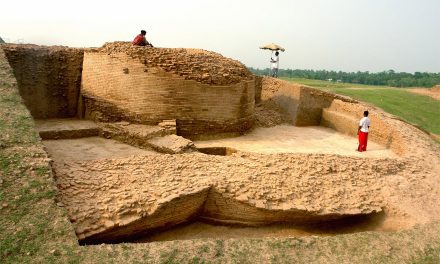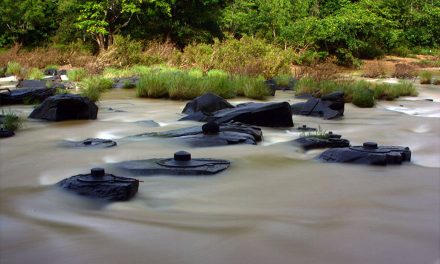Located in the western Godavari district, the village Antarvedi is located 15 km. from Sakhinetipalli mandal and 10 km. from Narsapur. The village is placed at the confluence of the Bay of Bengal and the Vasishta Godavari, one of the seven branches of the Godavari River. It is said that the sage Vasistha brought the River Godavari to its place, and this is one of the most sacred bathing spots in the entire Godavari delta. The place of confluence is known as the Sapta Sagara Sangam Pradesam. Antarvedi is the last and the most important of the seven sacred bathing spots positioned along the river here. Because of its sacred nature, it is also called “dakshina Kasi” (southern Kashi).
Antarvedi is one among the thirty-two most reputed Narasimha Kshetras of Andhra Pradesh, and is one of 108 Narasimhadeva shrines in the area. It is famous for the temple of Sri Lakshmi Narasimha Swamy, which was built during the 15th -16th centuries A.D. It’s sometimes called an island temple because Antarvedi has a tributory of River Godavari meeting the sea (Sagara Sangamam), whereas the Sri Lakshmi Narasimha Swamy temple is located on the other side, closer to the bank of Godavari, which is also called Vasishta Godavari.
One of the unique aspects of the Sri Lakshmi Narasimha Swamy temple is that the Deity is facing towards West instead of East, the usual direction. The main temple has a five-storey vimana (gopuram) and apart from the presiding Deity, Lord Nrsimhadeva, there are also Deities of Brahma, Vishnu, and Maheswara. Lord Brahma sanctified this place by performing the rudra yaga Vedic austerities here for purification, and it is therefore called ‘Antarvedi’. Neighboring temples include Nilakanteswara, Sri Rama, and Anjaneya. Nearer to Lakshmi Narasimha Swamy temple, Lord Shiva temple is also located, with Neelakanteswara and Brahma stapana.
The Story of Raktavilochana
In Kritayuga, Sanaka Rsi and his colleagues gathered at Naimisaranya to conduct Satra-yaga. During their leisure time, they would learn about the distinguished and significant holy places in Bharat, from Sri Suta Goswami. One day, they asked him to tell about the greatness and significance of Antarvedi shrine and of Lord Lakshmi Narasimha Swami. Sri Suta was pleased to tell the story, which was once told by Lord Brahma to Sage Narada.
Sage Vasista, after mingling the Goutami branch of the Godavari into the sea, established his Ashram there. Lord Brahma, to get freed from the sins he had committed against Lord Sankara, performed Rudra-yaga and installed Lord Neelakantheswara there. As that place was made a stage or vedik to perform the yaga, it was named “Antarvedi”. It is the place between the Vasishta river.
Raktavilochana, the son of Hiranyaksha, did tremendous penance for ten thousand years on the banks of Vasishta River to please Lord Siva and get his mercy. Lord Sankara was very much pleased with Raktavilochana’s penance and appeared before him. He promised to bless him with whatever he desired, and Raktavilochana asked for a boon wherein the number of sand particles drenched by the blood drops falling from his body onto the ground at war would produce an equal number of rakshasas as strong and vigorous as himself. The demons would then assist him at war and become one with him after killing all the enemies. Lord Sankara was astonished at the demon’s uncommon desire, but impressed by his penance he granted the demon’s desires. Raktavilochana then began harassing the brahmins, the demigods, the saints and the cows, and obstructed the yagas and Vedic rituals.
Sage Viswamitra later found an opportunity to take vengeance against the sage Vasishta, and provoked Raktavilochana to kill Vasishta’s hundred sons in his absence. The demon did so, causing an irreparable loss to Arundhati and Vasishta. Arundhati, Vasishta’s wife, wept terribly over the death of her sons and prayed to Vasishta, who was then at Brahmaloka. The sage, by his divine vision, came to know of all that had happened at this hermitage. He returned to his ashram and prayed for Lord Narasmiha’s grace, imploring the Lord to prevent Raktavilochana from wreaking further destruction.
Prahlada varadam Vishnum Nrusimham Paradivatam
Saranam Sarvalokaanaamaapannaarti Nivaaranam
To save his devotees, Lord Narasimhadeva appeared along with Goddess Lakshmi, and carried on Garuda Vahana, they appeared before Vasishta. After singing the Lord’s glories, Vasishta appealed to Him about the arrogance of the demon and his cruelty in killing his sons. He then prayed to the Lord to descend at his ashram after killing the demon, so that he could worship Him always there.
Lord Narahari blew the Panchajanya, inviting the demon to war. Raktavilochana heard the thundering noise of Panchajanya and like a cyclone, enveloped the Lord and engulfed Him in battle. The demon shot all types of weapons at the Lord, but Lord Narahari could attack and smash them with His only weapon, the Sudarsana Chakra. In this way He wounded the sensitive parts of the demon’s body.
As a result of the bloodshed, the soil particles drenched by the blood drops falling onto the ground from Raktavilochana’s body produced an equal number of demons as strong and vigorous as Raktavilochana, just as the earlier boon from Lord Shiva had promised. The demons having been thus generated they began hurting Garuda, who attacked them in such a way that they could not withstand him. The demon-king saw this and threw his weapons, one after another, at Sri Garuda but they could not harm him, as Lord Narahari destroyed them on the way with his Sudarsana Chakra.
The Lord also manifested Maya Shakti to help prevent the blood of the demon falling onto the ground. The Lord eventually chopped off the hands of Raktavilochana with Sudarshana Chakra and killed him, along with his asura fighters. The blood was stopped by Maya Shakti and was then released by her as a reddish river, which is known as the Raktakulya. This river cannot be crossed over, even by the demigods and demons.
Maya Shakti rode a horse, and so she is called Aswarudhamba, or Gurralakka. After killing the demons, the place where the Lord washed his chakra-yudha become known as Chakrateertham. A dip at that holy place will wash away all sins. There are five important spots at this holy shrine namely, the Sea, the Sagar Sangam, the Vasishta River, the Raktakulya River, and the Chakrateertham.
Joyous at the victory, Vashista consecrated the Deity of Lord Narasimha at Antervedi, and all the demigods came to sing of the Lord’s glories. The Lord told them about the significant greatness of the shrine in future. He described Antarvedi in many ways, including as being the easiest means for achieving the ultimate Mukti.
Later on at the request of the sages, Suta explained in detail about the sacred and splendid power of the Lord of Antarvedi, the affects of doing any harm to the place, and the remedy for it. He told them the story of Santhana as an illustration. Once Santhana by mistake lost his divinity and was cursed as unworthy to ascend to divinity. Indra’s sons used to take away all the flowers from a garden cultured by Ruchi at Antarvedi. Ruchi was very much worried about this. Lord Narahari appeared to him in a dream and advised him to keep the flowery remnants of worship of the temple around the garden. He did so on the next day. As usual, Indra’s son descended to the earth in his chariot, but he could not find them there, as he lost his divinity by passing over the flowery-remnants. Then his driver told him the cause for it. At his master’s request before returning to the Heavens, he also advised him to perform Mahasatrayaga for twelve years and to eat the food remnants after they were tasted by the Brahmins. Indra’s son did so, and the Brahmins learned from him about the purpose of doing so and blessed him. He then regained his divinity and returned to the Heavens, ascending in his divine chariot. Santhana was advised by Narada to follow Indra’s son, and he also did so at Antarvedi and regained divinity.
The Laksmi Narasimha Swami Temple
Over time during the Kaliyuga, Antarvedi became a jungle and the location of the Narasimha Swami Deity became lost. A cowherd named Keshavadas was grazing his cattle nearby, and one day he found that one of his cows, a reddish-brown cow from the herd, had rained her milk on an anthill behind a bush. She then returned home dry. This happened day after day. One day, Keshavadas followed her and saw what had been happening. Not understanding what was taking place, he was simply worried over the loss of milk. But Lord Narasimhadeva appeared in his dream and asked him to construct a temple for him at the spot where the milk was being offered. A brahmin scholar in the village who had sound knowledge of the sastras told Kesavadas that the Lord appearing in his dream meant that Lord Narasimha was to be worshipped and a temple erected there.
The cowherd, with the assistance of the villagers, constructed a temple at the anthill. They made a survey of the anthill area where the cow daily used to shed her milk, and dug the area after offering coconuts to the Lord. They found a stony sculptured form of Lord Narasimha and they built a temple right there, in that place. Daily rituals and festival events have been conducted there since that time. The village where Keshavadas lived is named after him, as Kesavadasupalem.
After some time, the temple fell into ruin, but it was re-built under the patronage of Sri Narendra Lakshmi Narasimha Rao, as an offering of thanks to the Lord for protecting his ships from going down at sea. He donated money and his men, who went to Bhadrachalam to purchase timber for the re-construction of the temple. The men selected logs and marked them with the Lord’s name, paying money for them.
After buying the logs, the men learned that there was no conveyance to transport the timber to Antarvedi. The water level of the Godavari River had become too low because of failure of the monsoons. They appealed to Narasimha Rao about the situation, and the gentleman did tapas in devotion of the Lord at the seashore, without food continuously for three days. However, the Lord didn’t shower Narasimha Rao with his grace.
Narasimha Rao then got angry and standing in seawater, he said that the Lord was a destitute lion who could not even come and see logs of wood arranged for the construction of His temple. That same night there was heavy rain which brought all the logs of wood that were marked with the Lord’s Name right to the gantaghat of Antarvedi. Thus the temple was erected. A foundation stone was laid for the reconstruction of the temple in 1923.
Temple Events and Festivals
The Lakshmi Narasimha Swami Kalyanam fair is celebrated each year on the Bhishma Ekadasi day during January-February. Lakhs of people attend the celebrations and the devotees come to take bath at the confluence of the sea and Vasishta Godavari. At the time of the nine-day mela, Antarvedi appears to be like a Kaliyuga Vaikuntha.
During the month of November, throngs of devotees come to the temple premises to witness the Deity of Narasimha Swamy without any of the ornaments, garb, or chandanam (sandal paste) that normally adorn the Lord’s Form.
In the month of Phalguna (January), the Lord’s chariot procession is held. Dolepournami celebrations are also held, when the Lord is worshipped with panchamrita abhishekam.













Thankq
I am very happy to saw these Hindu Gods .idols
And pictures very rare pictures.